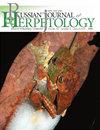韩国天马山红舌坑蛇(Gloydius ussuriensis)和中亚坑蛇(Gloydius intermedius)的分布格局和生态位
IF 0.9
4区 生物学
Q3 ZOOLOGY
引用次数: 3
摘要
物种分布的研究对于通过地理环境信息了解种间生态位和生境选择具有重要意义。特别是,同一属的毒蛇一直是一个重要的课题,因为它们在首选的地理环境中表现出差异,这取决于系统发育关系的距离。本研究于2012年4月至2014年10月对韩国天马山县公园山区红舌坑蛇(Gloydius ussuriensis)和中亚坑蛇(Gloydius intermedius)的地理环境进行了调查,以了解其栖息地特征与生态位之间的关系。红舌蝮蛇主要生活在太阳反射率低的低海拔、潮湿的山谷地区,而中亚蝮蛇则生活在阳光充足的高海拔、干燥的土地上。结果表明,从大部分地理环境变量来看,天马山地区红舌蝮蛇和中亚蝮蛇的生态位是低重叠的。不同的饮食偏好可能是影响两种间生态位分化的潜在关键因素之一。本文章由计算机程序翻译,如有差异,请以英文原文为准。
Distribution Patterns and Ecological Niches of the Red-tongued Pit Viper (Gloydius ussuriensis) and the Central Asian Pit Viper (Gloydius intermedius) in Cheonmasan Mountain, South Korea
Studies on the distribution of species are important to understanding the interspecific ecological niche and habitat selection through geographic environmental information. Particularly, vipers in the same genus have been an important topic because they show differences in the preferred geographical environment, depending on the distance of the phylogenetic relationship. This study investigated the geographical environment of red-tongued pit vipers (Gloydius ussuriensis) and Central Asian pit vipers (Gloydius intermedius) in the mountainous area, Cheonmasan Mountain County Park, South Korea, from April 2012 to October 2014, to understand the relationships among their habitat characteristics and ecological niche. Red-tongued pit vipers mainly lived in low altitude, wet valley areas with a low solar reflectance, while Central Asian pit vipers inhabited high altitude, dry land with large amounts of sunshine. As a result, our study supports that the ecological niche of red-tongued pit vipers and Central Asian pit vipers, inhibiting in Cheonmasan Mountain was overlapped low according to the majority of geographical environmental variables. The differentiated diet preference might be took into consideration as one of the potential key factors to the ecological niche differentiation among two species.
求助全文
通过发布文献求助,成功后即可免费获取论文全文。
去求助
来源期刊

Russian Journal of Herpetology
ZOOLOGY-
CiteScore
1.70
自引率
0.00%
发文量
29
期刊介绍:
Russian Journal of Herpetology is an international multi-disciplinary journal devoted to herpetology. Russian Journal of Herpetology accepts original papers on ecology, behavior, conservation, systematics, evolutionary morphology, paleontology, physiology, cytology and genetics of amphibians and reptiles.
Types of Contributions:
-original papers
-invited or contributed reviews on specific topics
-short communications on topics of immediate interest, new methods and ideas in progress
-notices of meetings, symposia, and short courses
-book reviews
 求助内容:
求助内容: 应助结果提醒方式:
应助结果提醒方式:


